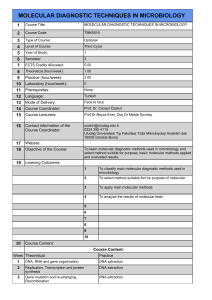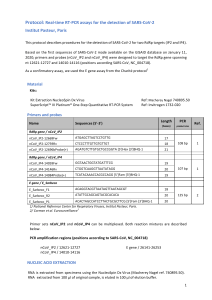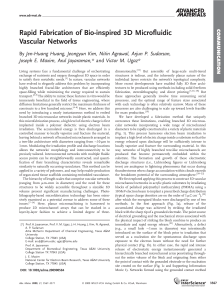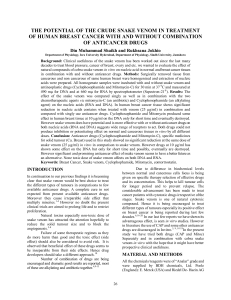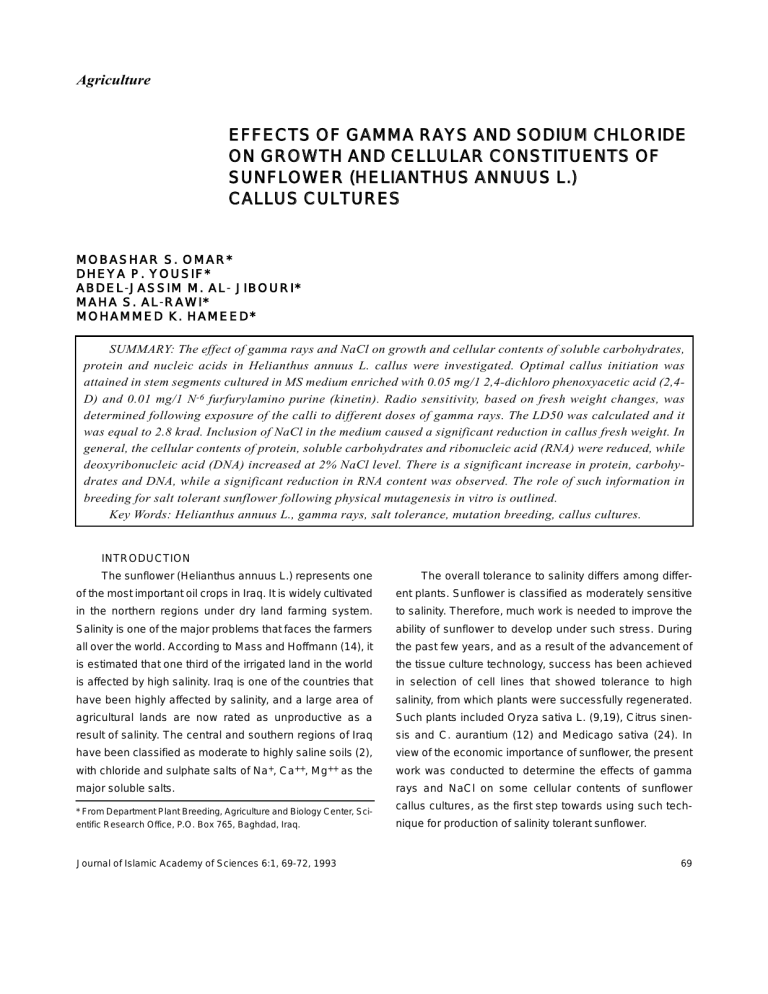
Agriculture
EFFECTS OF GAMMA RAYS AND SODIUM CHLORIDE
ON GROWTH AND CELLULAR CONSTITUENTS OF
SUNFLOWER (HELIANTHUS ANNUUS L.)
CALLUS CULTURES
MOBASHAR S. OMAR*
DHEYA P. YOUSIF*
ABDEL-J
J ASSIM M. AL- JIBOURI*
MAHA S. AL-R
R AWI*
MOHAMMED K. HAMEED*
SUMMARY: The effect of gamma rays and NaCl on growth and cellular contents of soluble carbohydrates,
protein and nucleic acids in Helianthus annuus L. callus were investigated. Optimal callus initiation was
attained in stem segments cultured in MS medium enriched with 0.05 mg/1 2,4-dichloro phenoxyacetic acid (2,4D) and 0.01 mg/1 N-6 furfurylamino purine (kinetin). Radio sensitivity, based on fresh weight changes, was
determined following exposure of the calli to different doses of gamma rays. The LD50 was calculated and it
was equal to 2.8 krad. Inclusion of NaCl in the medium caused a significant reduction in callus fresh weight. In
general, the cellular contents of protein, soluble carbohydrates and ribonucleic acid (RNA) were reduced, while
deoxyribonucleic acid (DNA) increased at 2% NaCl level. There is a significant increase in protein, carbohydrates and DNA, while a significant reduction in RNA content was observed. The role of such information in
breeding for salt tolerant sunflower following physical mutagenesis in vitro is outlined.
Key Words: Helianthus annuus L., gamma rays, salt tolerance, mutation breeding, callus cultures.
INTRODUCTION
The sunflower (Helianthus annuus L.) represents one
The overall tolerance to salinity differs among differ-
of the most important oil crops in Iraq. It is widely cultivated
ent plants. Sunflower is classified as moderately sensitive
in the northern regions under dry land farming system.
to salinity. Therefore, much work is needed to improve the
Salinity is one of the major problems that faces the farmers
ability of sunflower to develop under such stress. During
all over the world. According to Mass and Hoffmann (14), it
the past few years, and as a result of the advancement of
is estimated that one third of the irrigated land in the world
the tissue culture technology, success has been achieved
is affected by high salinity. Iraq is one of the countries that
in selection of cell lines that showed tolerance to high
have been highly affected by salinity, and a large area of
salinity, from which plants were successfully regenerated.
agricultural lands are now rated as unproductive as a
Such plants included Oryza sativa L. (9,19), Citrus sinen-
result of salinity. The central and southern regions of Iraq
sis and C. aurantium (12) and Medicago sativa (24). In
have been classified as moderate to highly saline soils (2),
view of the economic importance of sunflower, the present
with chloride and sulphate salts of
Na+,
Ca++,
Mg++
as the
major soluble salts.
* From Department Plant Breeding, Agriculture and Biology Center, Scientific Research Office, P.O. Box 765, Baghdad, Iraq.
Journal of Islamic Academy of Sciences 6:1, 69-72, 1993
work was conducted to determine the effects of gamma
rays and NaCl on some cellular contents of sunflower
callus cultures, as the first step towards using such technique for production of salinity tolerant sunflower.
69
EFFECTS OF g RAYS ON SUNFLOWER CULTURES
OMAR, YOUSIF, AL- JIBOURI, AL-RAWI, HAMEED
Table 1: Effect of 2, 4-D and kinetin on callus initiation from stem segments of sunflower (FAW genotype). Each number represent mean
fresh weight of 10 replicates.
2, 4-D mg/1 Conc
(A)
mean fresh weigt (mg) (B)
0.0
0.01
0.1
1.0
10.0
Mean
0.0
880.00
575.95
596.72
938.43
646.87
722.19
0.01
1051.60
695.50
395.25
764.00
550.00
691.27
0.05
577.00
990.71
477.39
749.33
1151.83
789.27
0.5
97.30
159.00
138.50
176.00
284.83
171.12
5.0
53.50
49.00
63.00
63.50
66.50
60.30
Mean
531.88
494.03
329.97
538.25
540.00
LSD (A) at 5% = 261.17
LSD (AB) at 5% = 116.8
MATERIALS AND METHODS
Seeds of Helianthus annuus L. genotype FAW (a mutant
which was developed in our center following gamma irradiation)
were surface sterilized, and their embryos cultured on minimal
organics medium. Following germination, stem segments, measuring, 1 cm long, were excised and cultured on Murashige and
Skoog (15) medium enriched with various concentrations of 2, 4D (0-5 mg/1) and kinetin (0-10 mg/1) to stimulate callus initiation.
The resulting callus was then propagated on the selected medium
by sub culturing twice until the desired amount of callus sufficient
for the irradiation experiment was attained. The callus was
exposed to different doses of gamma rays from a Co-60 source to
determine its radio sensitivity and to increase the genetic variations. The doses used in this experiment were 0.5, 1.0, 1.5 and
3.0 krad, in addition to the control. Following determination of the
LD50 (i.e. the dose that kills about 50% of the cells) which is suitable for mutation selection, the callus cultures that received this
dose were further propagated twice and sub-cultured on nutrient
medium enriched with 0, 0.5, 1.0, 2.0 and 3.0% NaCl as the salinity stress agent. The electrical conductivities (EC) of the media following NaCl additions were 5.88, 14.57, 23.52, 38.78 and 52.0
dS/m. The callus cultures were allowed to grow on such media
(containing NaCl) for 60 days in the culture room at 27±1°C in the
dark. Fresh weight was determined to evaluate the callus growth.
The cellular contents of protein, soluble carbohydrates and
nucleic acids were determined and adapted as parameters to
assess the effects of the stress agents on the cultured cells. Protein contents were measured by the Folin method (13), and the
soluble carbohydrates by the Phenol-Sulphuric acid method as
described by Herbert et al. (10). Total nucleic acids were determined following the method of Cherry (8) which is based on the
difference in the absorption at 260 and 290 nm. DNA was measured according to Burton (7) depending on the optical density at
600 nm. RNA was then calculated from the difference between
the total nucleic acids and DNA content. Standard curves for car70
bohydrates, protein, DNA and RNA were prepared with similarly
treated glucose, bovine serum albumin, calf thymus gland and
yeast nucleic acids, respectively.
RESULTS AND DISCUSSION
Following 4 weeks of incubation of stem segments on
nutrient medium enriched with different concentrations of
2,4-D and kinetin, callus initiation was observed in all test
combinations. However, the amount of callus initiated
varied at different hormonal supplementations (Table 1).
The best callus was initiated in nutrient medium enriched
with 0.05 mg/1 2,4-D and 0.01 mg/1 kinetin (Table 1).
Although higher fresh weight was attained in some other
treatments, the callus in such treatments was compact,
necrotic and showed a differentiation of some roots. The
general appearance of the callus in the selected treatment
had creamy to white color, and no necrotic regions were
observed. Callus propagation was achieved by subsequent subculture on nutrient medium enriched with 2,4-D
(0.05 mg/1) and kinetin (0.01 mg/1). The initiation of callus
Table 2: Effect of gamma rays on callus fresh weight.
Dose (Krad)
Fresh weight (mg)
0.0
2.90a
0.5
2.24b
1.0
1.81c
1.5
2.30a
3.0
1.45c
Numbers followed by the same letter within the column are not
significantly different according to Duncan's test at 0.05 level.
Journal of Islamic Academy of Sciences 6:1, 69-72, 1993
EFFECTS OF g RAYS ON SUNFLOWER CULTURES
Table 3: Effect of NaCI on callus fresh weight, carbohydrate and
protein in sunflower (FAW genotype).
NaCI conc.
callus fresh
weight (mg)
protein
carbonhydrates
(%)
(µg/mg)
(µg/mg)
0.0
1337 a
1.263 a
1.295 c
0.5
680 b
1.182 b
1.710 b
1.0
422 c
0.582 c
2.245 a
2.0
347 c
1.021 b
1.860 d
3.0
382 c
0.541 c
0.975 e
Numbers followed by the same letter within the column are not
significantly different according to Duncan's test at 0.05 level.
cultures from stem segments of sunflower has been
reported on similar hormonal supplementation (1).
The effect of gamma rays on callus fresh weight is
shown in Table 2. There was a significant reduction in
callus fresh weight with increased doses of irradiation. The
LD50 was 2.8 krad. A similar reduction in callus fresh
weight as a result of gamma irradiation has been reported
(4,11,16). This reduction in fresh weight may be caused by
the reduced amount of endogenous growth regulators,
especially the cytokines, as a result of break down, or lack
of synthesis, due to irradiation.
The effect of NaCl on callus fresh weight is shown in
Table 3. Sodium chloride caused a significant reduction in
callus fresh weight. The higher the NaCl concentration in
the culture medium caused the higher the reduction in
callus fresh weight. This is in agreement with the results
reported by several investigators (6, 22, 24). The reduction
in callus fresh weight might be a result of reduced water
availability in the culture medium due to increased NaCl
concentrations. The cellular contents of protein, soluble
carbohydrates and nucleic acids were also affected by the
presence of NaCl in the culture medium. Protein contents
were significantly reduced at all concentrations of NaCl
tested, with the maximum reduction being obtained at the
highest NaCl concentration (Table 3). A comparable level
of reduction in protein content was also observed at the
1% NaCl level which was not significantly different from
that associated with the 3% level. There was a sudden rise
in protein content at the 2% NaCl level, which may be possibly caused by the presence of NaCl tolerant cells within
the callus that received such treatment. The contents of
carbohydrates were also significantly reduced at the highest NaCl concentration (Table 3). However, there was a
Journal of Islamic Academy of Sciences 6:1, 69-72, 1993
OMAR, YOUSIF, AL- JIBOURI, AL-RAWI, HAMEED
significant increase at the intermediate level. At 1% NaCl
level, the highest amount of soluble carbohydrates was
detected, which may also suggest the presence of tolerant
cells. Results presented in Table 4 indicate no significant
changes in total nucleic acid contents in different NaCl
concentrations, however, a non-significant reduction was
observed at the 1 and 2% NaCl level. On the other hand,
the DNA contents were increased with the increased NaCl
concentration, while RNA decreased. A significant
decrease in RNA was observed at the 2% NaCl, while a
significant increase in DNA content was detected at the
same level. In fact, at the 2% NaCl level, a significant
increase in protein, carbohydrates and DNA was observed
while significant reduction in RNA was attained. This suggests that this level of NaCl may be the appropriate level
for selection of NaCl tolerant cell line.
The reduction in protein contents noticed in this
investigation is in accordance with the results of other
investigators (18, 20, 22, 23). High concentration of NaCl
in the culture medium may affect protein synthesis through
inhibition of some enzymes that regulates the process of
protein synthesis, especially nitrate reductase (17). This
reduction may also result from reduced RNA content,
which is necessary for protein synthesis (3). Carbohydrate
contents were generally reduced with increased NaCl concentrations. However, their increase at specific NaCl concentrations may have resulted from the hydrolysis of
protein into simpler compounds. The reduction in soluble
carbohydrate contents in NaCl containing media probably
resulted from the conversion of the insoluble into soluble
Table 4: Effect of NaCI on nucleic acid contents (µg/mg) of sunflower callus.
NaCI conc.
Total nucleic
acids
DNA
RNA
(%)
0.0
0.417 (1.345)
0.107 (0.816)
0.310 (1.317)
0.5
0.414 (1.827)
0.083 (2.590)
0.358 (2.128)
1.0
0.213 (2.75)
0.112 (0.445)
0.101 (2.212)
2.0
0.223 (2.45)
0.172 (4.008)*
0.051 (3.057)*
3.0
0.458 (2.168)
0.116 (0.148)
0.342 (1.858)
*: significant at the 5% level
Numbers in parenthesis represent calculated t value.
71
EFFECTS OF g RAYS ON SUNFLOWER CULTURES
carbohydrates such as starch. These observations are in
agreement with the findings of others (3, 21, 25).
Presence of NaCl in the culture medium also reduced
DNA and RNA contents. The process of DNA synthesis is
connected to protein synthesis. Therefore, the reduction in
RNA content will ultimately reduce the protein content,
since RNA is required for the process of protein synthesis
through transferring the amino acids into protein synthesis
centers (26). It is also possible that NaCl may also
hydrolyze the ribosomes which are necessary for protein
synthesis, or activate RNase that catalyzes RNA hydrolysis, and subsequently reduces protein synthesis.
This investigation showed that irradiation and NaCl
has drastic effects on callus fresh weight and the cellular
constituents of sunflower. Information gained from this
study were further used in currently going program aiming
towards developing salt tolerant cell lines through selection
in vitro. Such cell lines will be further used for regeneration
of possibly salt tolerant sunflower plants.
REFERENCES
1. Al-Salih HS : Effect of some growth regulators on growth,
protein, RNA, DNA and carbohydrate content of sunflower (Helianthus
annuus L.). MSc Thesis, Univ Mosul, p 141, 1987.
2. Al-Yasiri SA and Al-Zubaidi AJ : The relationship between soil
salinity and osmotic pressure during various plant developmental
stages. Second Sci Conf, Sci Res Found Baghdad, Iraq, 1975.
3. Bajaj YPS : Effects of gamma irradiated sugars on the growth
and development of plant tissue cultures. Z Pflanzenphysiol, 65:418426, 1971.
4. Bajaj YPS : Direct and indirect effects of gamma irradiation on
plant tissue cultures. Int Symp Use of Isotopes and Radiation in Agric
and Animal Husbundary. I A R I Delhi, Kapoor Art Press, pp 285-301,
1973.
5. Bernestein L : Salt tolerance of plants U S D A Agric Bull, No
203, 1964.
6. Binzel ML, Hasegawa PM, Handa AK and Bressan RA :
Adaptation of tobacco cells to NaCl. Plant Physiol, 79:118-125, 1985.
7. Burton K : A study of the conditions and mechanisms of the
diphenylamine reaction for the colorimetric estimation of deoxyribonucleic acid. Biochem J, 62:315-323, 1956.
8. Cherry JH : Nucleic acid determination in storage tissue of
higher plants. Plant Physiol, 37:670-678, 1962.
9. Groughan TP, Stavarek SJ, Rains DW : In vitro development
of salt resistant plants. Environ Exp Bot, 21:317-324, 1981.
10. Herbert D, Phillips PJ, Strange RE : Methods in Microbiology. Ed by JR Norris and DW Robbins, Acad Press, London, New
York, 1971.
11. King PJ : Selection for plant variations using cultured cells.
pp 199-214. In: Efficiency in plant Breeding. Ed by W Lange, AC
Zeven and NG Hogenboom. Pudoc Press, Wageningen.
72
OMAR, YOUSIF, AL- JIBOURI, AL-RAWI, HAMEED
12. Kochba J, Ben Hayyim G, Speigel-Roy P, Saad S, Neumann
H : Selection of stable salt tolerant callus lines and embryos in Citrus
sinensis and C aurantium. Z Pflanzenphysiol, 106:111-118, 1982.
13. Lowry OH, Rosebrough NJ, Farr AL, Randull RJ : Protein
measurement with Fol in phenol reagent. J Biol Chem, 193:295-297,
1951.
14. Mass EV and Hoffman G : Managing saline soil for irrigation.
Texas Technical Inst, Texas, 1976.
15. Murashige T and Skoog F : A revised medium for rapid
growth and bioassays with tobacco tissue cultures. Physiol Plant,
15:473-487, 1962.
16. Omar MS : Effect of gamma ray on callus cultures and asexual embryo genesis in Phoenix dactylifera L. Data Palm J, 6:258-264,
1988.
17. Plant Z : Nitrate reductase activity of wheat seeding during
exposure to and recovery from water stress and salinity. Physiol Plant,
30:212-217, 1974.
18. Ramagopal S : Sodium chloride effects on differentiation and
protein synthesis in root meristem cultures of two contrasting barley
genotypes. Plant Physiol, 132:245-249, 1988.
19. Reddy PJ and Vaidyanath K : In vitro selection for salt tolerance in Basmati rice. Indian J Plant Physiol, 28:88-91, 1985.
20. Reddy PJ and Vaidyanath K : In vitro characterization of salt
stress effects and the selection of salt tolerant plants in rice (Oryza
Sativa L.). Theor Appl Genet, 71:757-760, 1986.
21. Saleh FA, Saif HA, Omar MS : Effects of sodium chloride on
carbohydrate, protein and nucleic acid contents in four wheat (Triticum
aestivum L.) cultivars cultured in vitro. Agric Med, p 120 (in press),
1990.
22. Singh NK, Handa AK, Hasegawa PM, Bressan RA : Proteins
associated with adaptation of cultured tobacco cells to NaCl. Plant
Physiol, 79:126-137, 1985.
23. Smith MK and McComb JB : Effect of NaCl on growth of
whole plants and their corresponding callus cultures. Aust J Plant
Physiol, 8:267-275, 1981.
24. Mith MK and McComb JB : Selection for NaCl tolerance in
cell cultures of Medicage sativa L. and recovery of plants from a
NaCl tolerant cell line. Plant Cell Rep, 2:126-128, 1983.
25. Stavarek SJ and Rains DW : Effects of salinity on growth
and maintenance costs of plant cells. In: Proc Cellular and Molecular Biology of Plant Stress. Ed by BL Alan, pp 129-143, 1985.
26. Udovenko GV, Khazova CV, Lukyanova NM : Phosphate
metabolism in plants under condition of salinization. Sov Plant
Physiol, 18:1003-1009, 1971.
Correspondence:
Dheya P. Yousif
Agriculture and Biology Center,
Scientific Research Office,
P.O. Box 765,
Baghdad, IRAQ.
Journal of Islamic Academy of Sciences 6:1, 69-72, 1993

